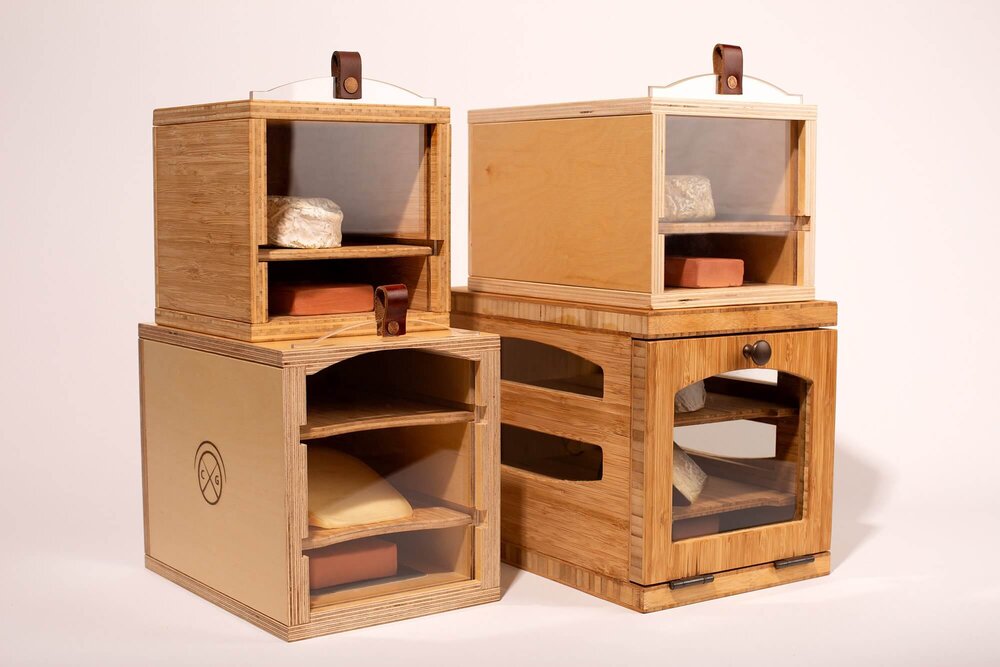Jessica Sennett photo credit Jessica Sennett Cheese Grotto
Cheese is, at its essence, a method for preserving milk beyond its typical shelf life. Harder cheeses especially are built to age and store, so that they may be enjoyed even years beyond the date their milk was born. How and where you store your cheese—of any kind—matters significantly, in terms of prolonging its life even further, as well as maintaining its flavor integrity. If anyone could be considered a cheese storage expert, it’s Jessica Sennett, founder of Cheese Grotto, a company that produces cheese storage boxes that partially mimic the climate of cheese caves.
“It’s a particular niche, for sure,” says Sennett, who also remarks that her path to cheese storage expert was an “organic” one, after a decade spent in various aspects of the cheese industry. Cheese Grotto was developed because she saw a need to be “the bridge between the rural and urban experience of cheese,” where those of us without a farm or cheese cave can still create a suitable cheese environment in our own kitchens.
After a transformative job as a cheesemonger at San Francisco’s Cowgirl Creamery as a young woman, Sennett pursued cheesemaking internships in France in lieu of college. She followed that up by work experiences at Monteillet Fromagerie, Formaggio Kitchen, and Bedford Cheese Shop in turn. At Bedford, where she helped to launch a cheese education program, she found that one of the most commonly asked questions by students was, “how do you store cheese?” This consumer need, along with her desire to stay on the guest-facing side of the cheese industry, combined with her deep knowledge of the cheese-making process, lead her to founding Cheese Grotto.
Whether you are in the market for your own Cheese Grotto, or just want to better understand what to do with your artisanal cheese when you bring it home, Sennett offers a “holy trinity” of principles upon which any ideal cheese storage method must adhere:
“Essentially cheese requires its own little microclimate,” she says, “with a balance of airflow, humidity, and temperature control.”

Air Flow
“Cheese is a live fermenting item, so it continues to release CO2 as it continues to ripen, so that’s why you need both fresh air access and a release of the air,” says Sennett.
In her various Cheese Grotto models, this is accomplished by a breathable back panel in the wooden cheese storage box, which allows air to travel around the cheese in a controlled manner. “You want to have this nice, gentle flow of air, not stagnant air, and not have it be too aggressive so that the cheese doesn’t dry out and oxidize.”
Air tight wrappers or containers such as plastic wrap, plastic bags, or plastic containers (such as Tupperware), are things to be avoided. If your pre-cut cheese comes wrapped in plastic, the best thing to do after bringing it home is to remove it from the plastic in favor of a different storage method. Sennett even recommends letting the cheese breathe a moment, and then scraping off the outer layer, since plastic can also leave a perceptible residue and mute the flavor of the cheese.

Breathable solutions such as cheese paper, wax paper, or even butcher paper are better alternatives that allow the cheese its necessary airflow. (Our editor, Amy Sherman, recommends the modestly priced, but highly effective cheese paper sold by Sennett’s former employer Formaggio Kitchen.) These methods can all trap moisture, however, and so wrappings should still be changed frequently. (More on the love/hate relationship between cheese and moisture below.)
Air flow is also important in terms of how far apart you keep distinct cheeses stored. Pungent cheeses will keep their flavors to themselves, as long as they are given an inch or two of personal space, and not forced shoulder-to-shoulder with more delicate cheeses.
“Alessi Cheese Dome” by Didriks is licensed under CC BY 2.0
Humidity
If cheese had a hospitality clause in its contract, its demand for humidifiers would be diva-level. “Cheese does like to be stored at a higher humidity,” says Sennett. “With a Cheese Grotto it’s a base of 70% (when empty,) which increases to 80% with cheese.” (Your cheese is literally exhaling constantly, fogging up your car windows from the inside.)
You can give your stored cheeses a humidity boost in several ways. In addition to its breathability, quality cheese paper does contain a sealant to help keep a little moisture in and establish a humid atmosphere, but with a two-ply system that wicks the moisture away from the surface of the cheese itself. Giving your wrapped cheese a dedicated drawer in your refrigerator also bumps up the humidity, as does utilizing a cheese dome for storage.
Damp air is not the same as moisture on the surface of the cheese, however, and this is another element where the wrong container can do more harm than good. Sennett again cautions against air-tight containers where collecting condensation can then drip back down on top of the cheese itself, which is an invitation for bacterial growth.
Anto Cheese Platter Photo by Anto Meneghini on Unsplash
Temperature
Temperature is the aspect of cheese storage that is most variable depending on the rate of your consumption of cheese, or how you plan to use or serve it. While cheese is best served at room temperature as a cheese course or cheese plate, if your use of cheese is strictly for cooking, then there’s no need to temper it before the cooking process.
“Refrigeration controls the rate of fermentation,” explains Sennett, “if you want it to last as long as humanly possible.” For maximum flavor and depth of aged cheeses especially, Sennett offers that they can be kept at room temperature outright: “I’d recommend under 70 degrees and enjoyed within a few days.”
For further reading on storage and other cheese accouterments, check out our Cheese Gear Shopping Guide.
